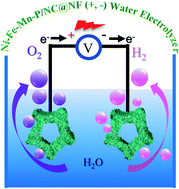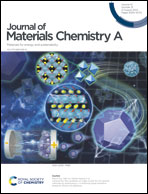A hybrid trimetallic–organic framework-derived N, C co-doped Ni–Fe–Mn–P ultrathin nanosheet electrocatalyst for proficient overall water-splitting†
Abstract
The development of multi-metal mixed organic-framework (MMOF)-derived phosphides as promising bifunctional electrocatalysts in energy conversion holds great potential for water splitting due to the high porosity, surface area, crystallinity and exposure of more active functional sites and super inherent catalytic efficacy they offer. Herein, we have fabricated hybrid carbon shell encapsulated nitrogen trimetallic phosphide (Ni–Fe–Mn–P) ultrathin nanosheets derived from a pristine trimetallic-organic framework (Ni–Fe–Mn-MOF) grown on nickel foam using 2-aminoterephthalic acid as the ligand. The curved edge, nitrogen and carbon co-doped trimetallic-organic framework-derived phosphide grown on nickel foam (Ni–Fe–Mn–P/NC@NF) demonstrates low overpotentials of 72 mV at 10 mA cm−2 for the hydrogen evolution reaction (HER) and 274 mV at 30 mA cm−2 for the oxygen evolution reaction (OER), with corresponding Tafel slopes of (79.8 and 56.8) mV dec−1 for the HER and OER, respectively, in 1 M KOH electrolytic solution. The efficient and highly stable electrocatalyst, when constructed as a Ni–Fe–Mn–P/NC@NF (+, −) device, exhibits a cell voltage of 1.52 V at 10 mA cm−2, lower by 0.06 V than that of the benchmark device RuO2@NF (+)//Pt–C@NF (−) at the same current density. We believe this work opens the way for Ni–Fe–Mn–P/NC@NF (+, −) to be applied in industrial overall electrocatalytic water-splitting.



 Please wait while we load your content...
Please wait while we load your content...